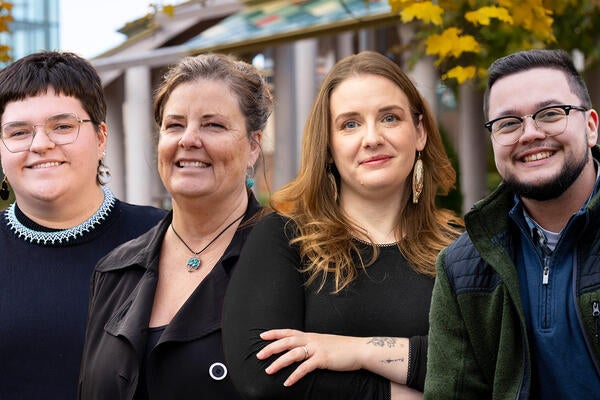
Raising awareness on gender-based violence
Annual Bridge installation honours more than 5,000 lives of missing and murdered Indigenous Women, Girls and Two Spirit People

Annual Bridge installation honours more than 5,000 lives of missing and murdered Indigenous Women, Girls and Two Spirit People
By Angelica Marie Sanchez University RelationsOn November 10, the University of Waterloo community came together to participate in the closing ceremony of Bridge: Honouring the Lives of Missing and Murdered Indigenous Women, Girls and Two Spirit People (MMIWG2S).
Students, staff and faculty gathered around the ceremonial fire grounds in front of United College as the closing ceremony was led by the Shatitsirótha' Waterloo Indigenous Student Centre (WISC), Al MacDonald, the Fire Keeper for the site, the Office of Indigenous Relations (OIR), the Sexual Violence Prevention Response Office (SVPRO) and Dr. Sorouja Moll, a professor in the Faculty of Arts.
Bridge is an annual installation initiated by Moll to create a space for all University community members to learn and raise awareness about the crisis of the murdered and missing, as a result of gender and race-based violence.

“The power of research, the power of asking questions, the power of community and the power of asking, ‘how can I help?’, are all very important, particularly to the violence against Indigenous people,” explained Moll, who initiated the Bridge project over a decade ago when she started questioning the reported statistics of MMIWG2S across Canada.
“We came up with the idea of the bridge to not only connect the campuses, but to also connect the lives of Indigenous and non-Indigenous people. It’s important to find space for those stories and listen to those who have been silenced so they can be heard.”
Originally a research-creation project titled, The Writing Names Project, by Moll in Montreal in 2009, it was then introduced to the University of Waterloo as a permanent initiative on campus. Since 2016, Bridge has become a source of dialogue between Indigenous and non-Indigenous communities across Waterloo, and where non-Indigenous people can continue to learn about the depth of crisis in Canada and reflect on our responsibility as a country to do better.

Savanah Seaton, director of WISC, shared a few of the statistics from the 2017 report on Missing and Murdered Indigenous Women and Girls, which reports that between 1980 and 2014, there were 6,849 police-reported female homicide cases in Canada and 16 per cent of those cases were of Indigenous women.
Seaton expressed that talking about MMIWG2S can be a heavy conversation for Indigenous people as it directly involves their loved ones. But listening to these stories while acknowledging that there are Indigenous communities and families that are still grieving, is very important when raising awareness on gender-based violence.
“It’s a miracle that any of us Indigenous women are here today, and it shouldn’t be that way,” Seaton added. “When we cut off each tie one a time, think about that person and consider that’s a whole entire life that has a family that cares for them, loves them, misses them and wants them to be here.”
At the opening ceremony, the names were read as the red fabric was tied to the bridge. The installation stands as a counter memorial against the silencing for 16 days. As part of the closing ceremony, participants removed each of the red ties one at a time from the bridge that connects United College and the Environment 3 building. Students, staff and faculty offered a moment of reflection and prayer as they carefully placed each of the red ties into a fire, followed by pieces of paper with names of more than 5,000 MMIWG2S written on them.

MacDonald, a sacred Fire Keeper for more than 20 years, said Indigenous communities believe that once the Ceremonial Fire has been lit, the fire becomes a portal to the spirit world and by burning the red fabric ties, our prayers to them and their families go into the smoke before being carried up to Creator, while the spirits of their ancestors join us during the ceremony.
“We are all individuals and as a collective we create communities which then creates societies, which then creates a change — that sets the tone for what's happening around us,” said Robin Stadelbauer, associate director of OIR, at the end of the closing ceremony.
“You being here is an act of Reconciliation. We are giving remembrance to these women, girls and Two Spirit People, and their families and communities who are experiencing loss. Today is a ripple effect to our greater society and an example of how we must meet to move forward together.”
WISC, OIR, SVPRO and Moll encourages everyone, both Indigenous and non-Indigenous people, to change the narrative by continuing to have these difficult conversations with their families and network of people.
Reflecting on the MMIWG2S can be difficult for many people. If you’re struggling or need someone to talk to, please reach out for support. Here are some resources
Empower Me (create an account on the Dialogue mobile app or on the web at www.studentcare.ca/dialogue)

Read more
A winter holiday message from President Vivek Goel

Read more
Researchers awarded funding to investigate ecology, climate change, repatriation, health and well-being through cultural and historical lens

Read more
Shop Canadian this holiday season with festive porch plants, fashion-forward apparel, craft spirits and more from Waterloo entrepreneurs
The University of Waterloo acknowledges that much of our work takes place on the traditional territory of the Neutral, Anishinaabeg, and Haudenosaunee peoples. Our main campus is situated on the Haldimand Tract, the land granted to the Six Nations that includes six miles on each side of the Grand River. Our active work toward reconciliation takes place across our campuses through research, learning, teaching, and community building, and is co-ordinated within the Office of Indigenous Relations.